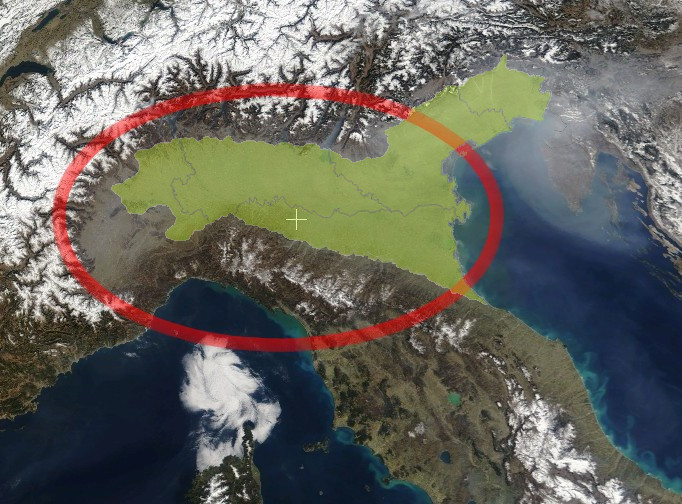|
San Bernardino Pass
San Bernardino Pass (, , ) is a high mountain pass in the Swiss Alps connecting the Hinterrhein and the Mesolcina (Misox) valleys between Thusis ( canton of Graubünden) and Bellinzona ( canton of Ticino). Located in the far eastern side of the Western Alps it is not to be confused with the Great St Bernard Pass and the Little St Bernard Pass. The top of the pass represents both the Italo-German language frontier and the watershed (drainage divide) between the Po basin and the Rhine basin. Marscholsee is within the pass at an elevation of . The route first became important as a mule track in the fifteenth century when the route between Thusis and Splügen was known as the Via Mala. A road for wheeled vehicles was opened in 1770; this road was significantly improved between 1821 and 1823, financed in part by the Kingdom of Sardinia, keen to improve a trade route connecting Genoa and Piedmont to the Graubünden that was not directly controlled by Austria A ... [...More Info...] [...Related Items...] OR: [Wikipedia] [Google] [Baidu] |
Swisstopo
Swisstopo is the official name for the Swiss Federal Office of Topography, Switzerland's national mapping agency. The current name was made official in 2002. It had been used as the domain name for the homepage of the instituteswisstopo.admin.ch since 1997. Maps The main class of products produced by Swisstopo are topographical maps on seven different Scale (map), scales. Swiss maps have been praised for their accuracy and quality. Regular maps * 1:25.000. This is the most detailed map, useful for many purposes. Those are popular with tourists, especially for famous areas like Zermatt and St. Moritz. These maps cost CHF 13.50 each (2004). 208 maps on this scale are published at regular intervals. The first map published on this scale was ''1125 Chasseral'', in 1952. The last map published on this scale was ''1292 Maggia'', in 1972. Since 1956, composites have been published, starting with ''2501 St. Gallen''. They have the same information, but consist of several parts of re ... [...More Info...] [...Related Items...] OR: [Wikipedia] [Google] [Baidu] |
Po Basin
The Po Valley, Po Plain, Plain of the Po, or Padan Plain (, , or ) is a major geographical feature of northern Italy. It extends approximately in an east-west direction, with an area of including its Venetian Plain, Venetic extension not actually related to the Po (river), Po basin; it runs from the Western Alps to the Adriatic Sea. The flatlands of Veneto and Friuli are often considered apart since they do not drain into the Po, but they effectively combine into an unbroken plain, making it the largest in Southern Europe. It has a population of 17 million, or a third of Italy's total population. The plain is the surface of an in-filled system of ancient canyons (the "Apennine Foredeep") extending from the Apennine Mountains, Apennines in the south to the Alps in the north, including the northern Adriatic. In addition to the Po and its affluents, the contemporary surface may be considered to include the Savio (river), Savio, Lamone (river), Lamone and Reno (river), Reno to the ... [...More Info...] [...Related Items...] OR: [Wikipedia] [Google] [Baidu] |
List Of Mountain Passes
This is a list of mountain passes. Africa Egypt * Halfaya Pass (near Libya) Lesotho * Moteng Pass * Mahlasela pass * Sani Pass Morocco * Tizi n'Tichka South Africa * Eastern Cape Passes * Western Cape Passes * Northern Cape Passes * KwaZulu Natal Passes * Free State Passes * Limpopo Province Passes * Mpumalanga Passes * Gauteng Passes * Northwest Province Passes * Swartberg Pass (Western Cape) * Lootsberg Pass Asia Afghanistan * Broghol Pass to Pakistan * Dorah Pass to Pakistan * Hajigak Pass * Khost-Gardez Pass * Khyber Pass to Pakistan * Kotal-e Khushk * Kushan Pass linking northern Afghanistan to the region. * Lataband Pass * Tang-e Gharu is a gorge which links Afghanistan with Pakistan * Salang Pass crosses the Hindu Kush linking Kabul with northern Afghanistan – nowadays through a tunnel. * Wakhjir Pass to China China * Pingxingguan Pass, Shanxi * Jiayu Pass, Gansu * Jianmen Pass, Sichuan * Niangzi Pass, Border between Shanxi and Hebei * Ya ... [...More Info...] [...Related Items...] OR: [Wikipedia] [Google] [Baidu] |
List Of Highest Paved Roads In Europe
This is a list of the highest paved roads in Europe. It includes roads that are at least long and whose culminating point is at least above sea level. This height approximately corresponds to that of the highest settlements in Europe and to the tree line in several mountain ranges such as the Alps and the Pyrenees, where most of the highest roads are located. Some of the listed roads are closed to motorized vehicles, although they are normally all accessible to pedestrians and cyclists. These mountain roads are visited by drivers, motorcyclists, bicyclists and hikers for their scenery and often feature in the routes of European bicycle races such as the Giro d'Italia, the Tour de Suisse, the Tour of Austria, the Tour de France and the Vuelta a España. Due to snow conditions, most of the high roads are closed between (late) autumn and late spring/early summer. Notes: * Some places have several names, usually because of locating in an area with multiple official languages or lo ... [...More Info...] [...Related Items...] OR: [Wikipedia] [Google] [Baidu] |
Laghetto Moesola Und Hospiz Am San Bernardino Pass
Laghetto is a frazione of the comune of Colico, Lombardy, northern Italy. Laghetto is a new name designed to combine many places, such as Borgonuovo, Fiumarga, La Cà and Corte, in a single village, the name officially appearing in 1770. In 1760 began the migration of some families who lived in Olgiasca following a tax dispute with the Austrian. Sights include the church of Saint Fidelis of Como. See also *Villatico * Curcio *Olgiasca Olgiasca is a frazione of the comune of Colico (Province of Lecco), northern Italy. It is located in the eponymous peninsula on the northern eastern shore of the Lake Como. A manse, consisting of the hill of Olgiasca in 1241 was leased from the ch ... Sources *Giovanni Del Tredici, Elena Fattarelli, ''Colico e il Monte Legnone – Sentieri e Storia'', CAI Colico, 2007 Frazioni of the Province of Lecco Colico {{Italy-geo-stub it:Colico#Laghetto ... [...More Info...] [...Related Items...] OR: [Wikipedia] [Google] [Baidu] |
History Of Austria
The history of Austria covers the history of Austria and its predecessor states. In the late Iron Age Austria was occupied by people of the Hallstatt Celtic culture ( 800 BC), they first organized as a Celtic kingdom referred to by the Romans as Noricum, dating from 800 to 400 BC. At the end of the 1st century BC, the lands south of the Danube became part of the Roman Empire. In the Migration Period, the 6th century, the Bavarii, a Germanic people, occupied these lands until it fell to the Frankish Empire established by the Germanic Franks in the 9th century. The name ''Ostarrîchi'' (Austria) has been in use since 996 AD when it was a margravate of the Duchy of Bavaria and from 1156 an independent duchy (later archduchy) of the Holy Roman Empire (962–1806). Austria was dominated by the House of Habsburg and House of Habsburg-Lorraine from 1273 to 1918. In 1806, when Emperor Francis II of Austria dissolved the Holy Roman Empire, Austria became the Austrian Empire, and was ... [...More Info...] [...Related Items...] OR: [Wikipedia] [Google] [Baidu] |
Piedmont
Piedmont ( ; ; ) is one of the 20 regions of Italy, located in the northwest Italy, Northwest of the country. It borders the Liguria region to the south, the Lombardy and Emilia-Romagna regions to the east, and the Aosta Valley region to the northwest. Piedmont also borders Switzerland to the north and France to the west. Piedmont has an area of , making it the second-largest region of Italy after Sicily. It has 4,255,702 inhabitants as of 2025. The capital of Piedmont is Turin, which was also the capital of the Kingdom of Italy from 1861 to 1865. Toponymy The French ''Piedmont'', the Italian ''Piemonte'', and other variant cognates come from the medieval Latin or , i.e. , meaning "at the foot of the mountains" (referring to the Alps), attested in documents from the end of the 12th century. Geography Piedmont is surrounded on three sides by the Alps, including Monte Viso, Monviso, where the Po River, river Po rises, and Monte Rosa. It borders France (Auvergne-Rhône ... [...More Info...] [...Related Items...] OR: [Wikipedia] [Google] [Baidu] |
Genoa
Genoa ( ; ; ) is a city in and the capital of the Italian region of Liguria, and the sixth-largest city in Italy. As of 2025, 563,947 people live within the city's administrative limits. While its metropolitan city has 818,651 inhabitants, more than 1.5 million people live in the wider metropolitan area stretching along the Italian Riviera. On the Gulf of Genoa in the Ligurian Sea, Genoa has historically been one of the most important ports on the Mediterranean: it is the busiest city in Italy and in the Mediterranean Sea and twelfth-busiest in the European Union. Genoa was the capital of one of the most powerful maritime republics for over seven centuries, from the 11th century to 1797. Particularly from the 12th century to the 15th century, the city played a leading role in the history of commerce and trade in Europe, becoming one of the largest naval powers of the continent and considered among the wealthiest cities in the world. It was also nicknamed ''la S ... [...More Info...] [...Related Items...] OR: [Wikipedia] [Google] [Baidu] |
Kingdom Of Sardinia
The Kingdom of Sardinia, also referred to as the Kingdom of Sardinia and Corsica among other names, was a State (polity), country in Southern Europe from the late 13th until the mid-19th century, and from 1297 to 1768 for the Corsican part of this kingdom. The kingdom was a member of the Council of Aragon and initially consisted of the islands of Corsica and Sardinia, sovereignty over both of which was claimed by the papacy, which granted them as a fief, the (Kingdom of Sardinia and Corsica), to King James II of Aragon in 1297. Beginning in 1324, James and his successors Aragonese conquest of Sardinia, conquered the island of Sardinia and established ''de facto'' their ''de jure'' authority. In 1420, after the Sardinian–Aragonese war, the last competing claim to the island was bought out. After the union of the crowns of Aragon and Crown of Castile, Castile, Sardinia became a part of the burgeoning Spanish Empire. In 1720, the island and its kingdom were ceded by the House o ... [...More Info...] [...Related Items...] OR: [Wikipedia] [Google] [Baidu] |
Via Mala
Viamala or Via Mala ( Romansh: literally, "bad path") is a narrow gorge along the river Hinterrhein between Zillis-Reischen and Thusis in the Canton of Graubünden, Switzerland, as well as the ancient and notorious pathway which traverses the gorge. Historically the Viamala was the most serious obstacle on the approach to the Splügen and San Bernardino mountain passes. History Antiquity A Viamala pathway already existed in Roman antiquity, though it is unclear whether it was only a foot and bridle path, or also passable by wagons. Two access paths met at the northern entrance to the Viamala gorge, which the Romans traversed by means of several rock galleries cut into the gorge's left walls. The Romans also constructed a wooden bridge crossing over to the right side of the Hinterrhein, routing traffic via Reischen to Zillis. Presumably this bridge was located somewhere below today's automobile bridge near the existing Pùnt da Suransuns pedestrian bridge. 1473 Via ... [...More Info...] [...Related Items...] OR: [Wikipedia] [Google] [Baidu] |









